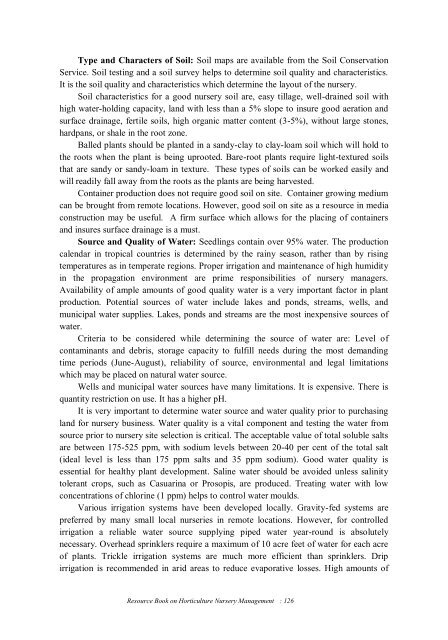Resource Book on Horticulture Nursery Management
Resource Book on Horticulture Nursery Management
Resource Book on Horticulture Nursery Management
You also want an ePaper? Increase the reach of your titles
YUMPU automatically turns print PDFs into web optimized ePapers that Google loves.
Type and Characters of Soil: Soil maps are available from the Soil C<strong>on</strong>servati<strong>on</strong><br />
Service. Soil testing and a soil survey helps to determine soil quality and characteristics.<br />
It is the soil quality and characteristics which determine the layout of the nursery.<br />
Soil characteristics for a good nursery soil are, easy tillage, well-drained soil with<br />
high water-holding capacity, land with less than a 5% slope to insure good aerati<strong>on</strong> and<br />
surface drainage, fertile soils, high organic matter c<strong>on</strong>tent (3-5%), without large st<strong>on</strong>es,<br />
hardpans, or shale in the root z<strong>on</strong>e.<br />
Balled plants should be planted in a sandy-clay to clay-loam soil which will hold to<br />
the roots when the plant is being uprooted. Bare-root plants require light-textured soils<br />
that are sandy or sandy-loam in texture. These types of soils can be worked easily and<br />
will readily fall away from the roots as the plants are being harvested.<br />
C<strong>on</strong>tainer producti<strong>on</strong> does not require good soil <strong>on</strong> site. C<strong>on</strong>tainer growing medium<br />
can be brought from remote locati<strong>on</strong>s. However, good soil <strong>on</strong> site as a resource in media<br />
c<strong>on</strong>structi<strong>on</strong> may be useful. A firm surface which allows for the placing of c<strong>on</strong>tainers<br />
and insures surface drainage is a must.<br />
Source and Quality of Water: Seedlings c<strong>on</strong>tain over 95% water. The producti<strong>on</strong><br />
calendar in tropical countries is determined by the rainy seas<strong>on</strong>, rather than by rising<br />
temperatures as in temperate regi<strong>on</strong>s. Proper irrigati<strong>on</strong> and maintenance of high humidity<br />
in the propagati<strong>on</strong> envir<strong>on</strong>ment are prime resp<strong>on</strong>sibilities of nursery managers.<br />
Availability of ample amounts of good quality water is a very important factor in plant<br />
producti<strong>on</strong>. Potential sources of water include lakes and p<strong>on</strong>ds, streams, wells, and<br />
municipal water supplies. Lakes, p<strong>on</strong>ds and streams are the most inexpensive sources of<br />
water.<br />
Criteria to be c<strong>on</strong>sidered while determining the source of water are: Level of<br />
c<strong>on</strong>taminants and debris, storage capacity to fulfill needs during the most demanding<br />
time periods (June-August), reliability of source, envir<strong>on</strong>mental and legal limitati<strong>on</strong>s<br />
which may be placed <strong>on</strong> natural water source.<br />
Wells and municipal water sources have many limitati<strong>on</strong>s. It is expensive. There is<br />
quantity restricti<strong>on</strong> <strong>on</strong> use. It has a higher pH.<br />
It is very important to determine water source and water quality prior to purchasing<br />
land for nursery business. Water quality is a vital comp<strong>on</strong>ent and testing the water from<br />
source prior to nursery site selecti<strong>on</strong> is critical. The acceptable value of total soluble salts<br />
are between 175-525 ppm, with sodium levels between 20-40 per cent of the total salt<br />
(ideal level is less than 175 ppm salts and 35 ppm sodium). Good water quality is<br />
essential for healthy plant development. Saline water should be avoided unless salinity<br />
tolerant crops, such as Casuarina or Prosopis, are produced. Treating water with low<br />
c<strong>on</strong>centrati<strong>on</strong>s of chlorine (1 ppm) helps to c<strong>on</strong>trol water moulds.<br />
Various irrigati<strong>on</strong> systems have been developed locally. Gravity-fed systems are<br />
preferred by many small local nurseries in remote locati<strong>on</strong>s. However, for c<strong>on</strong>trolled<br />
irrigati<strong>on</strong> a reliable water source supplying piped water year-round is absolutely<br />
necessary. Overhead sprinklers require a maximum of 10 acre feet of water for each acre<br />
of plants. Trickle irrigati<strong>on</strong> systems are much more efficient than sprinklers. Drip<br />
irrigati<strong>on</strong> is recommended in arid areas to reduce evaporative losses. High amounts of<br />
<str<strong>on</strong>g>Resource</str<strong>on</strong>g> <str<strong>on</strong>g>Book</str<strong>on</strong>g> <strong>on</strong> <strong>Horticulture</strong> <strong>Nursery</strong> <strong>Management</strong> : 126











